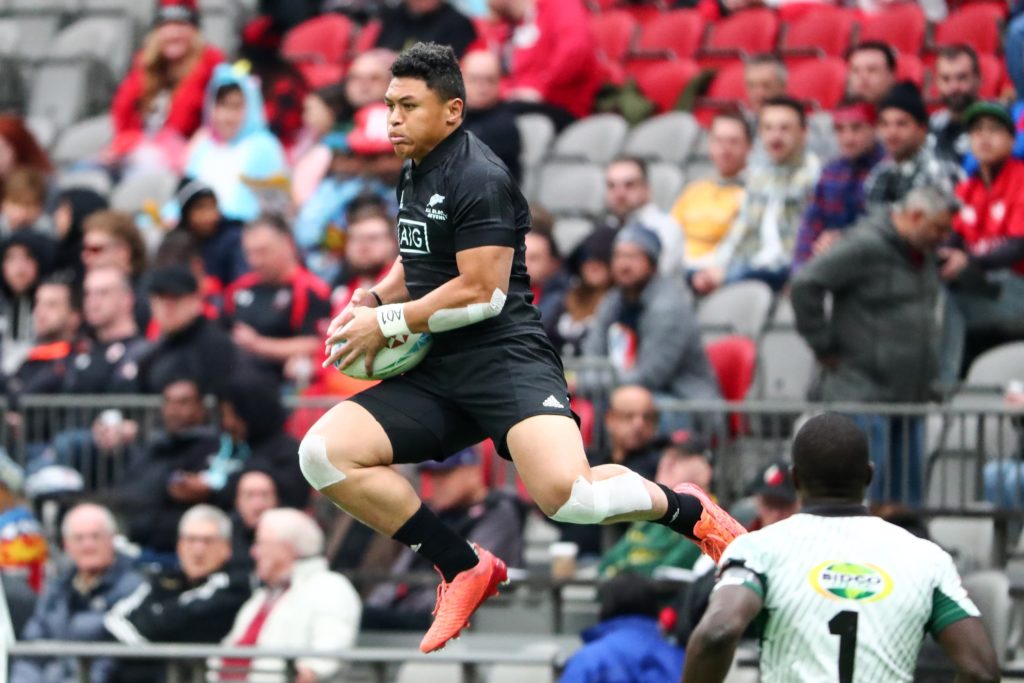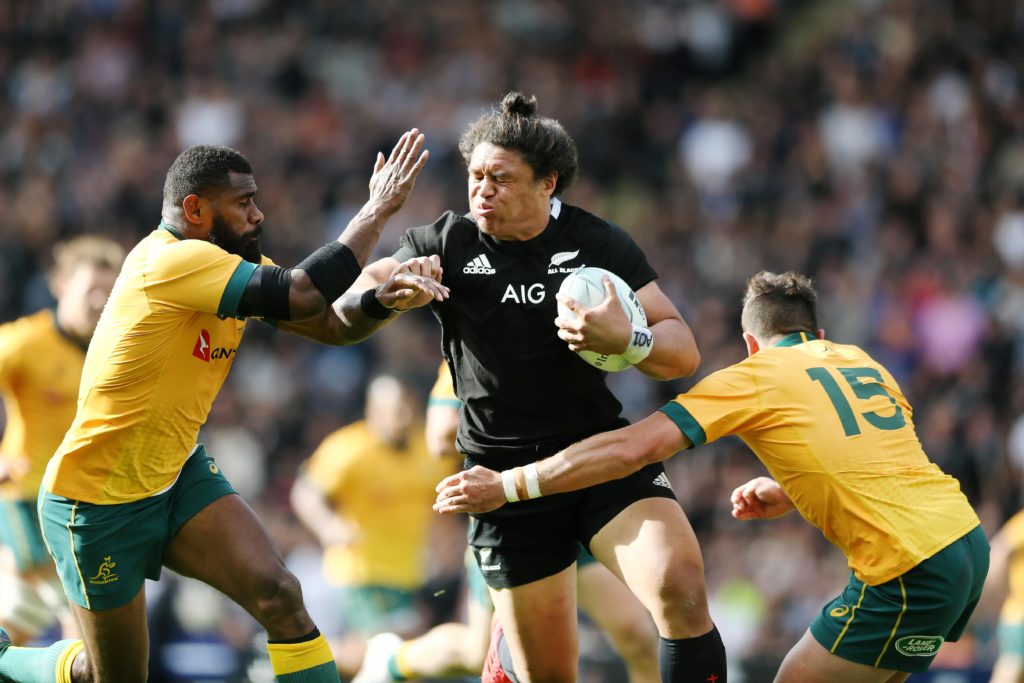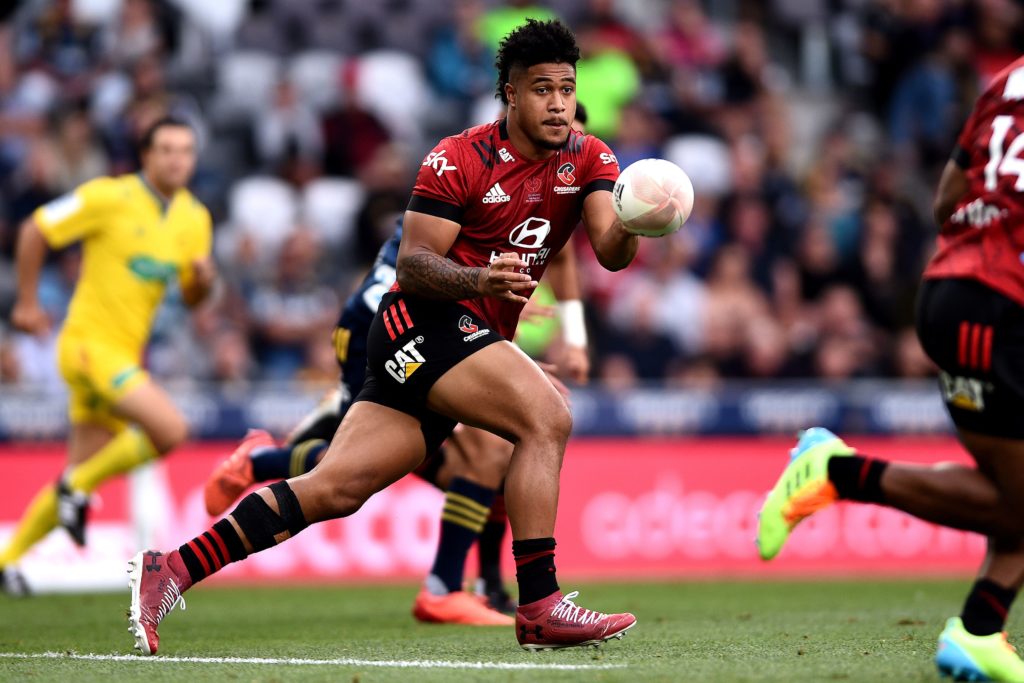Every Olympian is aware that their dream is chased with the certainty that sacrifice will be a travel companion on their journey.
Friends fall away, favourite foods are taken off the menu, study goes on hold, family are ignored – the list is probably endless of what the elite have to give up to make it to the world’s biggest sporting event.
But for Caleb Clarke, the rugby sensation of 2020 who has opted to re-join the New Zealand Sevens team and head to Tokyo with them in July, what could be sacrificed is his regular starting spot on the All Blacks left wing.
The 22-year-old has taken a career risk by opting to chase Olympic glory this year. Others may disagree, point out that he’s young and likely to return from Japan whippet-fit, intensely sharp and potentially mentally energised by the whole experience.
That’s definitely one possibility. Sevens, has proven to be a useful means to invigorate or accelerate the progress of others in the past.
In 2005 both Joe Rokocoko and Ma’a Nonu were sent to the abbreviated game by the All Blacks coaching group of that time. It was felt both would benefit from the austere conditioning regime imposed by then sevens coach Gordon Tietjens.

Both trimmed off a bit of excess weight and resumed their All Blacks careers all the better for it.
In 2010, Ben Smith was in a career lull. He’d won a solitary test cap in 2009 but was unable to force his way back into the squad. He was starting to wonder if he ever would and was eying up an offshore offer to leave.
That all changed when he was picked to play sevens at the Commonwealth Games. He came home with a gold medal and a renewed love of the game and a desire to stick around and become a long-term All Black.
No doubt then, sevens does have the ability to re-direct or kick-start a fledgling All Blacks career. It has shown itself to be a useful tool to fast-track a peripheral All Black into a regular squad pick.
But it is interesting to note that Nonu and Rokocoko played sevens 16 years ago and Smith 11. Rugby has changed almost beyond recognition since then, becoming so much more physical, collision-based and technical that it bares virtually no resemblance to the abbreviated game anymore.
History is littered with examples of players being given an unexpected chance to play test football for New Zealand and pushing on to become major superstars.
Sevens is a great vehicle for enhancing generic skills and encouraging kick-catch techniques that can be taken into the 15-a-side game, but that’s about it. The two versions are now entirely separate games and playing one no longer enhances the ability to play the other.
That’s partly why Smith was reluctant to commit to playing sevens in 2016 and try to make the Olympic team that year.
“I was in a tough position,” he would say after turning down the chance to play sevens. “I did want to have a go at the sevens but also wanted to be part of the Highlanders…it’s a tough job to do both,” Smith. “It was a massive decision at the time – there are always going to be tough decisions so you just make it and get on with things. The Highlanders have worked really hard to get where we’ve got to and I want to continue on and be part of that. “
As much as he felt he had to commit in full to the Highlanders who were the defending Super Rugby champions that year, he also had concerns about what would happen to his All Blacks place if he took the time out to go to the Olympics.
Coach Steve Hansen had assured Smith he would support him if he decided to go to Rio, which would have seen him miss the June series against Wales, the first two Bledisloe Cup tests and probably the next two Rugby Championship games against Argentina and South Africa as well.

The reality wasn’t lost on Smith, however, that no matter what Hansen said, in his absence, someone else would have the chance to play and in the All Blacks, that’s a massive risk.
History is littered with examples of players being given an unexpected chance to play test football for New Zealand and pushing on to become major superstars.
Look at Sean Fitzpatrick. He caught one lucky break in 1986 when the players who toured with the Cavaliers were suspended and then another, when two days before the first test against France, Bruce Hemara had to withdraw from the starting team because of injury.
Luck got him in, hard work, raw talent and ferocious application kept him there. This is what happens with the All Blacks, an opportunity arises and someone will take it and never look back.
Ardie Savea reached the same conclusion in 2016. He committed to the Olympics only to change his mind when his form for the Hurricanes was so compelling it became apparent he was going to make the All Blacks.
When they are hot they have to make the most of it. The streak of form Clarke was in doesn’t often last as long as everyone imagines and there are many incredible prospects who burned out as fast as they arrived.
If he tried to flit between sevens and fifteens, he worried it would be detrimental to his career. There he was on the cusp of test selection and what good would it do to him to play a massively aerobic game for two months, where he would inevitably lose weight and have to regain it and a heap of lost ground once he came back from the Olympics? He realised that just because he’d got within touching distance of selection in April 2016, that wouldn’t guarantee he’d still be there in August after the Olympics.
Which brings us back to Clarke, who in October last year was being compared, with good reason, to the late Jonah Lomu. The Auckland youngster had destroyed the Wallabies at Eden Park with his power running and the All Blacks had found the power wing they had been looking for since Julian Savea lost his way in 2017.
He instantly became the All Blacks first choice left wing, well ahead of Sevu Reece who had a quiet year, George Bridge who was out injured and Rieko Ioane, who was attempting to recast himself as a midfielder.
But the thing about All Blacks wings, particular those reliant on their pace and power, is that they don’t come with longevity.
When they are hot they have to make the most of it. The streak of form Clarke was in doesn’t often last as long as everyone imagines and there are many incredible prospects who burned out as fast as they arrived.

Savea being a classic case in point. He was bumping defenders out of the way for fun in his rookie season in 2012 and then dubbed by Steve Hansen as a better player than Lomu two years later. But by 2016, he was battling to keep his starting spot at the Hurricanes and in July 2017, he played his last test.
The All Blacks got four and a half good years out of him and that is about standard. Sitiveni Sivivatu was another great power wing who was unstoppable for five seasons. Rokocoko was much the same as was Waisake Naholo, while it can’t be said yet for how long Ioane was in his prime as a wing.
He was brilliant as a 20-year-old in 2017 and 2018 but in 2019, his form and confidence dipped and he lost his starting place on the left wing.
He remains a superb athlete and exciting player, but it is interesting that he’s made the switch to the midfield so early in his career.
While Reece isn’t a power wing, he is another to have shown how fickle things can be for exciting outside backs. He forced his way into the starting team in 2019 on the back of his magic feet and ability to score from anywhere but fell flat last year.
When Reece is in form, confident and playing well, it’s probably best to keep him going: to pick him, throw him the ball and tell him to trust his instincts.
He’s been much sharper and more effective in 2021 and probably sits at the moment as the man most likely to replace Clarke for the July and Bledisloe tests.
When Reece is in form, confident and playing well, it’s probably best to keep him going: to pick him, throw him the ball and tell him to trust his instincts.
The option is also there now for All Blacks coach Ian Foster to have a look at Leicester Fainga’anuku, the Crusaders wing-cum-centre who is almost a like-for-like replacement for Clarke. Fainga’anuku has been brilliant all year in both positions and has been backed by former All Black, Justin Marshall.
“What has impressed me about Fainga’anuku is that he had to show versatility following his move to centre once Jack Goodhue was ruled out,” Marshall wrote for The XV.
“Some people say if you can play wing you can play centre, too but that is simply not true. The running lines and defence – everything changes. Wings move off their sidelines and these days are more proactive, but centres don’t move so much and have to pick their lines. Fainga’anuku did a great job and showed his composure and maturity.”

And this is ultimately the risk Clarke has taken by giving others a chance: open the door in New Zealand and it is almost certain at least one if not two players will walk through it and establish themselves in the role.
By the time Clarke is available for selection again, one or possibly both of Fainga’anuku and Reece could have delivered a handful of compelling performances. Will Jordan could also be used on the wing and finding a spot in the All Blacks back three – where Jordie Barrett, Damian McKenzie, Bridge and possibly even Braydon Ennor, Ioane and Beauden Barrett are going to be vying for places, will be hard enough without giving the chasing pack five or six tests head start this year.
The additional problem could be that Clarke finds it hard to re-adjust to the 15-man game and it becomes a double whammy – he goes a step backwards and his rivals go a step forwards.
Clarke was on top of the world last year, but that’s all gone now and in this business, the picture can change quickly and dramatically.
For a long time, deep into the professional age, the All Blacks had an internal belief that it was best to never give a sucker an even break.
Clarke might find out in the next few months that there was good reason why they felt like that.



Comments
Join free and tell us what you really think!
Sign up for free